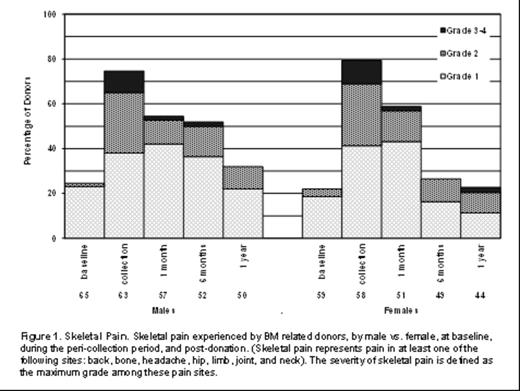Abstract
Prospective data regarding donation related toxicities and time to recovery in related donors (RDs) of bone marrow (BM) and peripheral blood stem cells (PBSC) are limited, in contrast to significant data available regarding unrelated donor experiences. To address this lack of data in RDs, the NHLBI-funded Related Donor Safety Study (RDSafe; NCT00948636) prospectively enrolled RDs of all ages between 2010 and 2013 at 54 transplant centers in the United States. RDs were assessed for pre-donation comorbidities and health status, and then followed for 1 year after donation, collecting detailed information on adverse events, pain levels and 10 collection-related NCI-CTC symptoms. This report describes baseline, peri-donation, and through 1 year post pain/symptoms for RDs aged 18-60: 124 BM (38 centers, med age 33, 48% female) and 919 PBSC (42 centers, med age 49, 44% female).
Results: About 20% of RDs reported pain and NCI-CTC symptoms at baseline, mostly grade 1, with females reporting pain/symptoms more often than males (see figures). Pain occurred in approximately 80% of donors surrounding collection with other symptoms occurring in 50-70% of donors. Pain and symptoms persisted in 10-20% of RDs at 1, 6, and 12 months; pain/symptoms returned to baseline in only a few categories assessed, but mostly remained elevated from baseline at 1 year. In addition, for both males and females, at 1 year grade 2-4 pain or symptoms were 2-3 times baseline rates. Multivariate analysis was performed on PBSC donors, where numbers were sufficient to look at key risk factors (see table). Females had more grade 3-4 pain at collection, and grade 2-4 pain and symptoms at 1 year. Age differences were noted, with RDs age 30-39 experiencing the highest amount of pain and symptoms and RDs age 50-60 experiencing less pain compared to donors aged 18-29. Pain or symptoms at baseline were important predictors of higher levels of reported pain/symptoms, respectively, during the collection and also higher risk of grade 2-4 pain at 1 year.
Conclusions: One in 5 RDs have mild/moderate pain and/or symptoms at baseline, and the presence of pain/symptoms at baseline increases risk for experiencing higher levels of pain/symptoms during collection. Although the majority of RDs return to baseline status within a month of donation, >10-20% of RDs have lingering pain/symptoms 6-12 months after donation, and rates of grades 2-4 pain and symptoms at 1 year are more than double baseline. Females have higher grades of pain with collection and more grade 2-4 pain and symptoms at 1 year compared to males. RDs should be informed of the risk of mild/moderate pain/symptoms lingering through the first year after donation. Ongoing efforts to correlate baseline comorbidities of RDs with outcomes should allow RDs to be better informed of risk and potentially identify clinical risk profiles where RDs should be deferred.
*Pain = max grade 2-4 or 3-4 2 days post-donation of BM or day+5 of PBSC collection (collection day 1).
**Symptoms = fever, fatigue, rash, local site reactions, nausea, vomiting, anorexia, insomnia, dizziness, and syncope
MV Analysis of PBSC RDs for pain and donation-related symptoms: Odds Ratio (p-value).
| . | Pain* . | Symptoms** . | |||
|---|---|---|---|---|---|
| day+5 Grd 2-4 | day+5 Grd 3-4 | 1yr Grd 2-4 | day+5 Grd 2-4 | 1yr Grd 2-4 | |
| Female | 1.667 (0.010) | 1.667 (0.016) | 1.887 (0.041) | ||
| Age | (0.001) | (0.008) | (<0.001) | ||
| Age 18-29 | 1.0 | 1.0 | 1.0 | ||
| Age 30-39 | 0.76 (0.306) | 2.2 (0.036) | 2.48 (0.008) | ||
| Age 40-49 | 0.68 (0.115) | 1.46 (0.283) | 1.49 (0.216) | ||
| Age 50-60 | 0.45 (<0.001) | 0.93 (0.836) | 0.93 (0.830) | ||
| Baseline pain overall | (0.001) | (0.004) | (<0.001) | ||
| Baseline pain Grd 0 | 1.0 | 1.0 | 1.0 | ||
| Baseline pain Grd 1 | 2.2 (<0.001) | 2.6 (0.06) | 2.95 (<0.001) | ||
| Baseline pain Grd 2-4 | 4.73 (<0.001) | 4.4 (0.002) | 3.95 (<0.001) | ||
| Baseline sx overall | (<0.001) | ||||
| Baseline sx Grd 0 | 1.0 | ||||
| Baseline sx Grd 1-4 | 2.16 (<0.001) | ||||
| . | Pain* . | Symptoms** . | |||
|---|---|---|---|---|---|
| day+5 Grd 2-4 | day+5 Grd 3-4 | 1yr Grd 2-4 | day+5 Grd 2-4 | 1yr Grd 2-4 | |
| Female | 1.667 (0.010) | 1.667 (0.016) | 1.887 (0.041) | ||
| Age | (0.001) | (0.008) | (<0.001) | ||
| Age 18-29 | 1.0 | 1.0 | 1.0 | ||
| Age 30-39 | 0.76 (0.306) | 2.2 (0.036) | 2.48 (0.008) | ||
| Age 40-49 | 0.68 (0.115) | 1.46 (0.283) | 1.49 (0.216) | ||
| Age 50-60 | 0.45 (<0.001) | 0.93 (0.836) | 0.93 (0.830) | ||
| Baseline pain overall | (0.001) | (0.004) | (<0.001) | ||
| Baseline pain Grd 0 | 1.0 | 1.0 | 1.0 | ||
| Baseline pain Grd 1 | 2.2 (<0.001) | 2.6 (0.06) | 2.95 (<0.001) | ||
| Baseline pain Grd 2-4 | 4.73 (<0.001) | 4.4 (0.002) | 3.95 (<0.001) | ||
| Baseline sx overall | (<0.001) | ||||
| Baseline sx Grd 0 | 1.0 | ||||
| Baseline sx Grd 1-4 | 2.16 (<0.001) | ||||
No relevant conflicts of interest to declare.
Author notes
Asterisk with author names denotes non-ASH members.



This feature is available to Subscribers Only
Sign In or Create an Account Close Modal